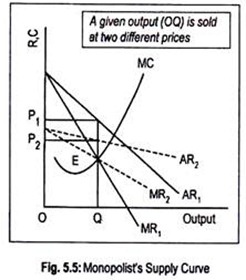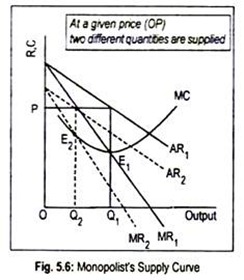Get the answer of: Why is it Impossible to Construct a Supply Curve under Monopoly?
A monopoly firm has no well-defined supply curve. In other words, there is no unique supply curve for the monopolist derived from his MC curve. Under perfect competition, short run MC curve above the shut-down point is the supply curve which shows a unique relationship between price and quantity. At a particular price, a particular amount of the commodity will be supplied.
Under monopoly, there is no such one-to-one correspondence between price and quantity supplied. This is because of the fact that output decision of a monopolist not only depends on marginal cost but also on the shape of the demand curve. “As a result, shifts in demand do not trace out a series of prices and quantities as happens with a competitive supply curve.”
It may happen that a monopolist, given his MC curve, may supply a particular quantity at different prices depending on the elasticity of demand. Thus, the construction of supply curve from the MC curve is impossible under monopoly or under any branch of imperfect competition.
ADVERTISEMENTS:
Fig. 5.5 shows that the monopolist produces and sells output OQ but at two different prices depending on the price elasticity of demand. AR1 and MR1 are the initial average and marginal revenue curves of the monopolist. If the demand curve is AR2 then the corresponding MR curve becomes MR2.
MC curve cuts MR1 and MR2 at point E. Corresponding to this equilibrium point, our monopolist produces and sells output OQ at the price OP1 if the demand curve is AR2, or he will sell the same amount at the price OP2 if the demand curve is AR2.
In other words, a higher price would be charged if product demand is less elastic (here AR1 has the lower value of elasticity than AR2). Thus, due to differences in elasticity of demand for the monopoly product, same quantity is offered for sale at two different prices. Thus, there is no unique relationship between price and quantity.
ADVERTISEMENTS:
Fig. 5.6 shows that two different quantities may be sold at a particular price depending on the elasticity of demand for the monopoly product. Here, MC curve cuts MR1 and MR2 at points E1 and E2 corresponding to the demand curves AR1and AR2, respectively.
The firm may produce and sell OQ1 (as determined by point E2) at the price OP or may produce and sell OQ2 (as determined by E2) at the same price OP. Thus two different quantities can be sold at the same price, given the MC of the monopolist. There is no unique relationship between price and quantity offered for sale.

